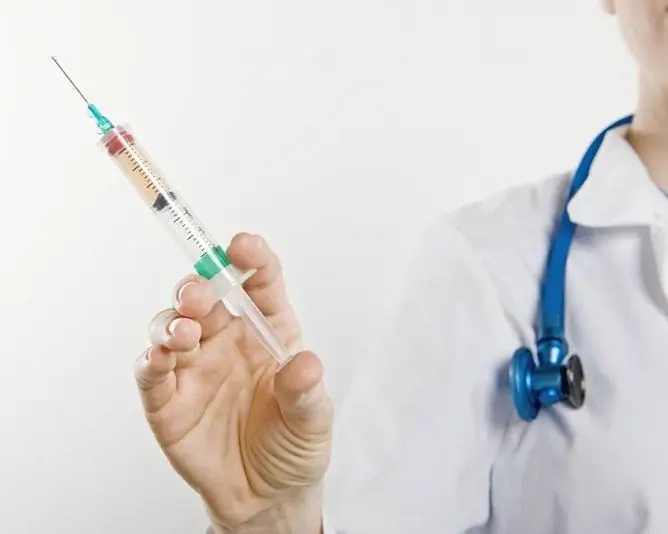- Author Rachel Wainwright [email protected].
- Public 2023-12-15 07:39.
- Last modified 2025-11-02 20:14.
Cefaxone
Cefaxon: instructions for use and reviews
- 1. Release form and composition
- 2. Pharmacological properties
- 3. Indications for use
- 4. Contraindications
- 5. Method of application and dosage
- 6. Side effects
- 7. Overdose
- 8. Special instructions
- 9. Application during pregnancy and lactation
- 10. Use in childhood
- 11. In case of impaired renal function
- 12. For violations of liver function
- 13. Use in the elderly
- 14. Drug interactions
- 15. Analogs
- 16. Terms and conditions of storage
- 17. Terms of dispensing from pharmacies
- 18. Reviews
- 19. Price in pharmacies
Latin name: Cefaxone
ATX code: J01DD04
Active ingredient: ceftriaxone (Ceftriaxone)
Manufacturer: Lupine Ltd. (Lupin Ltd.) (India)
Description and photo update: 2020-01-04

Cefaxone is an antibacterial drug of the third generation cephalosporin group for parenteral use.
Release form and composition
Dosage form - powder for the preparation of a solution for intravenous (i / v) and intramuscular (i / m) administration: white or white with a yellowish tinge (1000 mg each in colorless glass vials, sealed with a rubber stopper, rolled up with an aluminum cap and a closed plastic lid); in a cardboard box 1 bottle of powder and instructions for the use of Cefaxon).
1 bottle contains the active ingredient - ceftriaxone (in the form of ceftriaxone sodium trisesquihydrate), in an amount of 1000 mg.
Pharmacological properties
Pharmacodynamics
The active component of Cefaxone, ceftriaxone, is a third generation cephalosporin antibiotic. Its bactericidal action is based on inhibition of bacterial cell wall synthesis.
Ceftriaxone is resistant to β-lactamase enzymes produced by most gram-positive and gram-negative bacteria (penicillinase, cephalosporinase). The antimicrobial effect of Cefaxon extends to various types of aerobic and anaerobic microorganisms, both gram-positive and gram-negative.
In the course of laboratory (in vitro) and clinical studies, ceftriaxone has shown high antimicrobial activity against most of the known strains of microorganisms, listed below:
- gram-positive aerobes: Staphylococcus epidermidis, Staphylococcus aureus (including strains producing penicillinase), Streptococcus pneumoniae, Streptococcus viridans, Streptococcus A (Streptococcus pyogenes);
- gram-negative aerobes: Acinetobacter calcoaceticus, Enterobacter cloacae, Enterobacter aerogenes, Escherichia coli, Haemophilus influenzae (including strains with established ampicillin resistance and β-lactamase-producing strains, KP, KP, KP, KP, KP), KP, KP catarrhalis (including strains producing β-lactamase), Neisseria gonorrhoeae (including strains producing / not producing penicillinase), Neisseria meningitidis, Serratia marcescens, Proteus vulgaris, Proteus mirabilis strains, Pseudomonas aerugos; most of the known strains
- anaerobes: Clostridium species, Bacteroides fragilis, Peptostreptococcus species.
Pharmacokinetics
After parenteral administration, ceftriaxone is rapidly and completely absorbed. Its bioavailability is 100%. The maximum concentration (C max) in blood plasma is observed after 1.5 hours.
Ceftriaxone reversibly binds to plasma proteins (albumin) by 85-95% and remains in the body for a long time. In the minimum antimicrobial concentrations, the antibiotic is determined in the blood 24 hours after administration or more. It easily penetrates into bone tissue, organs and fluids (pleural, peritoneal, synovial). With inflammation of the membranes of the brain and / or spinal cord, the substance passes into the cerebrospinal fluid. The concentration of ceftriaxone in breast milk is 3-4% of its content in the blood serum (with i / m administration of the solution, this figure is higher than with i / v).
The half-life (T 1/2) after i / m administration is 5.8-8.7 hours. After i / v administration of a dose of ceftriaxone to children with meningitis at the rate of 50-75 mg / kg, T 1/2 varies in a small range - 4.3-4.6 hours. The active substance is excreted by the kidneys - up to 50% within 48 hours; partially excreted in the bile.
In case of failure of renal function, the elimination of ceftriaxone slows down, as a result of which its accumulation in the body is possible.
T 1/2 value in patients with impaired renal function, depending on CC (creatinine clearance):
- patients on hemodialysis (CC 0-5 ml / min) - 14.7 hours;
- CC 5-15 ml / min - 15.7 h;
- CC 16-30 ml / min - 11.4 h;
- CC 31-60 ml / min - 12.4 h.
Indications for use
The antibiotic Cefaxon is recommended for the treatment of infections and inflammations of the following localization caused by microorganisms that are sensitive to it:
- abdominal cavity (inflammatory diseases of the digestive tract and bile ducts, peritonitis);
- the brain and spinal cord (meningitis);
- bones, joints, connective tissue, skin;
- kidneys and urinary tract (urogenital infections, including gonorrhea);
- ENT organs and respiratory tract (including pneumonia).
An antibacterial drug is also used to treat sepsis; in the treatment of infections in patients with reduced immunity; in order to prevent bacterial infection in the postoperative period.
Contraindications
Absolute:
- hyperbilirubinemia in newborns;
- simultaneous use with intravenous administration of solutions containing calcium ions (Ca 2+), infants up to 4 weeks of age;
- I trimester of pregnancy;
- breast-feeding;
- individual hypersensitivity to ceftriaxone, as well as to other cephalosporins, carbapenems and penicillins.
With caution, Cefaxon is prescribed to premature babies, patients with renal / hepatic insufficiency, ulcerative colitis, enteritis or colitis associated with the use of antibacterial drugs, as well as in the II and III trimesters of pregnancy.
Cefaxon, instructions for use: method and dosage
The solution of Cefaxon prepared from powder is intended for intravenous or intramuscular administration.
For the treatment of newborns, ceftriaxone is used in a daily dose of 20-50 mg / kg.
The recommended dosage regimen for the treatment of children weighing less than 50 kg:
- infections of the skin and soft tissues: daily dose - 50-75 mg / kg, divided into two administrations (1 time in 12 hours);
- bacterial meningitis: initial dose - 100 mg / kg (but not more than 4000 mg) once a day; then 100 mg / kg per day (but not more than 4000 mg) for one administration or divided into 2 administrations (1 time in 12 hours). The duration of the course is from 7 to 14 days;
- acute otitis media: once in / m at a dose of 50 mg / kg (but not more than 1000 mg);
- other infections: the daily dose is 50-75 mg / kg, divided into 2 administrations (1 time in 12 hours). The maximum daily dose for children should not exceed 2000 mg.
When treating children weighing 50 kg or more, the dosage regimen for adults is used.
In the case of prescribing the drug in a dose of more than 50 mg / kg of body weight, Cefaxone is administered intravenously as an infusion for at least 30 minutes.
For adults and children over 12 years of age, ceftriaxone is administered once a day at a dose of 1000 to 2000 mg. In severe infections or infections caused by moderately sensitive pathogens, the daily dose can be increased to 4000 mg.
Therapy of gonorrhea caused by strains of Neisseria gonorrhoeae, which form and do not form penicillinase, is carried out by a single intramuscular injection of Cefaxone at a dose of 250 mg.
Before infected and potentially infected surgical interventions in order to prevent postoperative infections (depending on the risk of infection), a single administration of Cefaxone at a dose of 1000-2000 mg is recommended 30-90 minutes before the start of the surgical operation.
If the operation is performed on the colon and / or rectum, it is recommended to additionally use drugs from the 5-nitroimidazole group.
Methods for the preparation and administration of Cefaxone solution:
- intramuscularly: to dilute 1000 mg of ceftriaxone, 3.5 ml of 1% lidocaine solution is needed; the resulting solution is injected deep into the gluteus muscle. With a single injection into one buttock, it is recommended to inject no more than 1000 mg. Lidocaine should not be injected into a vein;
- intravenously: in the form of an injection - to dilute 1000 mg of ceftriaxone, 10 ml of distilled sterile water is needed, the resulting solution is injected intravenously slowly over 2-4 min; as an infusion - to dilute 2000 mg of ceftriaxone, approximately 40 ml of one of the solutions (free of Ca 2+) is needed, for example, 0.9% sodium chloride solution, 5% or 10% dextrose solution, 5% fructose solution (levulose); the duration of the infusion should be at least 30 minutes.
Side effects
- immune system: chills or fever, rash, hives, itching; rarely - eosinophilia, bronchospasm, polymorphic exudative erythema (Stevens-Johnson syndrome), angioedema, serum sickness, anaphylactic shock, Lyell's syndrome, allergic dermatitis, allergic pneumonitis;
- nervous system: convulsions;
- digestive system: nausea, vomiting, constipation / diarrhea, flatulence, abdominal pain syndrome, stomatitis, glossitis, taste disturbances, pseudomembranous colitis, impaired liver function (increased activity of bilirubin and / or liver enzymes: transaminases, less often alkaline phosphatase; cholestatic jaundice), dysbiosis, dyspepsia, colitis, cholelithiasis, sludge gallbladder syndrome;
- hematopoietic system: leukopenia, granulocytopenia, neutropenia, lymphopenia, thrombocytopenia, thrombocytosis, agranulocytosis, leukocytosis, basophilia, lymphocytosis, monocytosis, hypocoagulation, hemolytic anemia, a decrease in the level of blood coagulation factors (II, VII, IX, X) in the blood plasma time;
- genitourinary system: nephrolithiasis, vaginitis, impaired renal function (increased blood urea concentration, azotemia, hypercreatininemia, cylindruria, glucosuria, hematuria), oliguria / anuria;
- reactions at the injection site: soreness; with intravenous injection - phlebitis, induration along the vein; with intramuscular injection - a feeling of tightness, warmth or induration at the injection site;
- laboratory data: a decrease in prothrombin time, an increase in the concentration of urea, the presence of sediment in the urine;
- other reactions: headache, dizziness, flushing, increased sweating, palpitations, candidiasis, nosebleeds, superinfection.
Overdose
Symptoms of an overdose of Cefaxone are nausea, vomiting, diarrhea, convulsions, confusion, increased other dose-dependent negative side effects.
For the treatment of cases of drug intoxication, symptomatic measures are recommended. Hemodialysis or peritoneal dialysis does not reduce excessively high plasma ceftriaxone levels.
special instructions
Rare episodes of changes in prothrombin time are described in patients using Cefaxone. With a deficiency of vitamin K due to a violation of its synthesis in the body, nutritional errors or for other reasons, it may be necessary to monitor the prothrombin time, as well as (if it is lengthened before the start of the course or during treatment) taking vitamin K at a dose of 10 mg per week.
There is evidence of fatal reactions as a result of the formation of precipitates of calcium salts of ceftriaxone in the kidneys and lungs of newborns. Presumably, the interaction of ceftriaxone with intravenous solutions containing Ca 2+ is also possible in patients of other age groups. As a result, ceftriaxone should not be mixed with Ca 2+ -containing solutions (including drugs for parenteral nutrition), as well as administered simultaneously with them, including the use of separate infusions for infusions of different localization. The range between the introduction of ceftriaxone and Ca 2+ -containing solutions should theoretically be equal to five T 1/2ceftriaxone, which is at least 48 hours. There is no data on the interaction of ceftriaxone with oral preparations containing Ca 2+, as well as with its intramuscular administration simultaneously with Ca 2+ -containing preparations for oral administration and intravenous administration.
In rare cases, during therapy with Cefaxone, the development of pancreatitis was observed, possibly as a result of obstruction of the biliary tract. Many patients also had other risk factors for bile duct congestion, such as severe comorbidities, previous drug treatment, and total parenteral nutrition. However, this does not exclude the stimulating effect of ceftriaxone on the formation of precipitates in the biliary tract.
Ultrasound examination (ultrasound) of the gallbladder in some patients revealed opacities (precipitates of calcium salts of ceftriaxone), which disappear upon completion of treatment. If symptoms (signs) develop, indicating possible pathologies of the gallbladder, or if biliary sludge is detected based on the results of ultrasound of the hepatopancreatobiliary zone, it is recommended to stop using Cefaxone.
During therapy with Cefaxone, the Coombs test, galactosemia test and urine glucose test may give false positive results. The detection of glucosuria is recommended only by the enzymatic method.
Precautions
Patients with concomitant severe impairment of kidney and liver function, as well as those on hemodialysis, should regularly measure the level of ceftriaxone in the blood plasma due to a possible decrease in the rate of its excretion.
Long-term therapy with Cefaxone should be accompanied by regular monitoring of the peripheral blood picture, as well as indicators of the functional state of the liver and kidneys.
Before starting the course of Cefaxon, as well as before using other antibacterial drugs of the cephalosporin group, a detailed history is taken. However, this does not exclude the possibility of developing anaphylactic shock in the patient, requiring immediate therapy: first of all, intravenous epinephrine, then glucocorticoids.
In vitro studies have shown that ceftriaxone (like other cephalosporin antibiotics) is able to displace bilirubin from the zones of binding to serum albumin.
Weak and elderly patients may need to take vitamin K.
Influence on the ability to drive vehicles and complex mechanisms
There is no data on the effect of Cefaxone on the patient's ability to perform potentially hazardous activities, for example, driving vehicles or working with complex and high-precision mechanisms.
Application during pregnancy and lactation
The use of Cefaxone in the first trimester of pregnancy is contraindicated.
For the treatment of pregnant women in the II and III trimesters, the drug is prescribed only if the intended benefit to the mother is more clinically significant than the potential risk to the fetus.
If the use of Cefaxone is required during lactation, breastfeeding should be discontinued.
Pediatric use
In pediatric practice, the administration of injections of Cefaxone is contraindicated for the treatment of newborns with diagnosed hyperbilirubinemia, as well as, if necessary, injecting them into / in solutions that contain calcium ions.
With caution, the drug is prescribed to premature babies (born before the 36th week of pregnancy).
With impaired renal function
There is no need to reduce the dose of Cefaxone in patients with normal liver function and impaired renal function.
When treating patients with end-stage renal failure (CC less than 10 ml / min), the daily dose should not exceed 2000 mg.
Patients with severe combined liver and kidney disease require regular monitoring of serum ceftriaxone levels in the blood.
Patients on hemodialysis do not need to change the dose of Cefaxone after the procedure.
For violations of liver function
There is no need to reduce the dose of Cefaxone in patients with normal renal function with impaired liver function.
Use in the elderly
Elderly patients may need vitamin K during antibiotic therapy Cefaxon.
Drug interactions
The main types of pharmacological interactions with the combined use of ceftriaxone with other medicinal substances / drugs:
- aminoglycosides: synergize with Cefaxone against a number of gram-negative bacteria;
- antibacterial agents of bacteriostatic action: they reduce the bactericidal activity of Cefaxon, and chloramphenicol in vitro is its antagonist;
- ethanol: since ceftriaxone does not contain an N-methylthiotetrazole group, when it interacts with ethyl alcohol, the development of disulfiram-like reactions that are inherent in some other cephalosporins was not noted;
- non-steroidal anti-inflammatory drugs, other inhibitors of platelet aggregation: increases the likelihood of bleeding;
- loop diuretics and other nephrotoxic drugs: the risk of developing their nephrotoxic effects increases.
Cefaxone is pharmaceutically incompatible with aminoglycosides, amsacrine, vancomycin, fluconazole, solutions containing other antibiotics, and solutions containing calcium ions, including Hartmann and Ringer's solutions.
Analogs
Cefaxon analogs are Azaran, Azarexon, Axone, Biotraxon, Broadsef-S, Intrasef, IFICEF, Lendacin, Lifaxon, Medaxon, Movigip, Oframax, Rocefin, Stericsef, Tercef, Tornaxon, Torocef, Triaxon, Chizonef-S, Zefriogram …
Terms and conditions of storage
Store in a dry and dark place at temperatures up to 25 ° C. Keep out of the reach of children.
The shelf life is 3 years.
Terms of dispensing from pharmacies
Dispensed by prescription.
Reviews of Cefaxone
Cefaxon, according to patients' reviews, is an effective antibacterial agent both in the treatment of infections and in recovery in the postoperative period.
As a disadvantage, its high cost is most often indicated in comparison with analog drugs.
Price for Cefaxone in pharmacies
The price of Cefaxone registered in the list of vital and essential drugs (Vital and Essential Medicines) is 133.29 rubles. for a package containing 1 bottle with 1000 mg of powder for preparing a solution for intravenous and intramuscular administration. The cost of the drug in pharmacies is unknown because it is not available for sale.

Maria Kulkes Medical journalist About the author
Education: First Moscow State Medical University named after I. M. Sechenov, specialty "General Medicine".
Information about the drug is generalized, provided for informational purposes only and does not replace the official instructions. Self-medication is hazardous to health!






